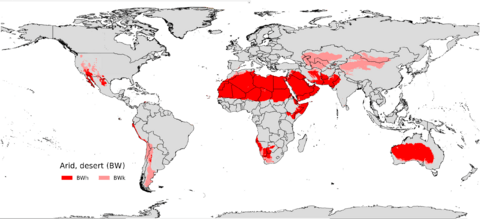Desert climate facts for kids
Desert climate or Arid climate (in the Köppen climate classification: BWh "hot desert climate" and BWk "cold desert climate") is a type of climate where precipitation is generally less than 250 millimetres (10 in) a year. Low rainfall is a feature of deserts such as the Arabian, central Australia and the Sahara. It is a feature of continental interiors, the western sides of continents, and the leeward side of tall mountain ranges. Parts of the Arctic and Antarctic have arid climates even though they are cold.
Defining a desert
A "true desert" is one where plant cover is very sparse and rainfall is rare or infrequent. Because desert air is dry there is little moisture to hold onto the heat of the day. Desert nights are usually very cold. This wide temperature variation can make a desert climate difficult to live in.
Some deserts get more than 250mm of rainfall yearly but are still arid areas. For example, the Kalahari Desert gets up to 640 millimetres (25 in) a year. It has great sand dunes like the Sahara, but they do not shift in the winds. They have plants that anchor the sand and help to keep their shape. Other areas can also have more than 250mm of precipitation but lose more water via evapotranspiration than falls as precipitation. Tuscon and Alice Springs are good examples of this. Tucson gets an average of 303 millimetres (12 in) of rainfall a year. Alice Springs receives about 540 millimetres (21 in) yearly. Some scientists do not consider these as true deserts.
Types
There are three types of desert climates in the Köppen climate classification: a hot desert climate (BWh), a cold desert climate (BWk) and a mild desert climate (BWh/BWn). Hot deserts have very hot summers that have temperatures that can even reach 45 °C (113 °F). Temperatures can even be very warm during winter. Cold deserts can have hot summers as well, but the winters are usually very cold. They are usually at high altitudes and can be drier than hot deserts.
Adaptations
Desert plants and animals have adapted to living in desert climates. Some animals can get by on less water. Some plants are able to store water. Some animals, like snakes, lizards and scorpions use poisonous venoms to kill for food. This saves valuable energy: they do not need to chase, fight or catch their prey. Many animals are nocturnal. They sleep in cool caves or burrows during the day and hunt at night. Plants likewise have adapted to saving water. Some have waterproof coverings that prevent the plant or seeds from drying out. Some, like the giant Saguaro cactus, store water. They have adapted so well that they can live for more than 150 years and can average over 40 ft tall. Many types have thorns and protective spines that keep animals from getting at their stores of water.
Related pages
See also
 In Spanish: Clima árido para niños
In Spanish: Clima árido para niños



